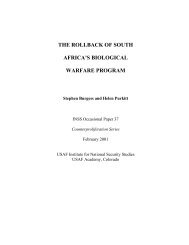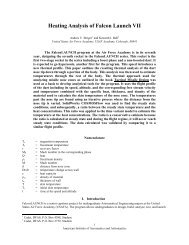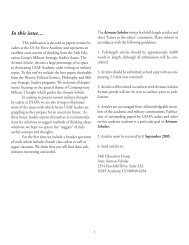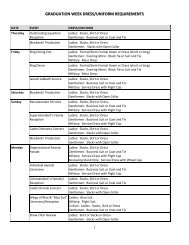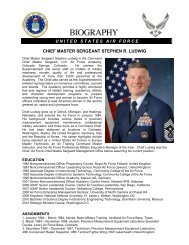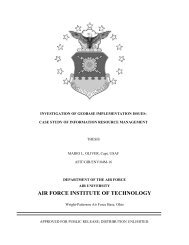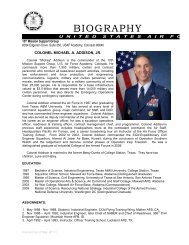Development of High Altitude Sprite Imagery Capability - Bruski
Development of High Altitude Sprite Imagery Capability - Bruski
Development of High Altitude Sprite Imagery Capability - Bruski
You also want an ePaper? Increase the reach of your titles
YUMPU automatically turns print PDFs into web optimized ePapers that Google loves.
United States Air Force Academy’s Meteorology Department. The flight reached a maximum altitude <strong>of</strong> 31 km and<br />
landed approximately 88 km north and east <strong>of</strong> the launch location. The unit was recovered successfully with the help<br />
<strong>of</strong> a last second SPOT® tracker unit from a local high school.<br />
B. Flight Two<br />
Flight two was a test <strong>of</strong> the SPOT® tracker at high altitudes, a new payload box, and a new parachute. The<br />
balloon flight was a launch and forgets mission since no live data was being sent down to the ground. The flight<br />
landed approximately 125 miles north and east <strong>of</strong> its launch location. The balloon was recovered at 11 pm in zero<br />
light conditions.<br />
C. Flight Three<br />
Flight three served as a test <strong>of</strong> the HD GoPro Hero Naked® video camera. The camera was pointed straight<br />
down to demonstrate that position for future flights. The flight also demonstrated the necessity <strong>of</strong> having a<br />
redundant tracking system as the APRS feed was lost when the balloon was approximately 762 meters in altitude.<br />
The SPOT® tracker successfully sent its position to the tracking website 170 miles from the launch site. The balloon<br />
was in the air for over four hours which contributed to the extreme distance the balloon landed from the launch site.<br />
A unusual wind pattern at 30 km was identified. Winds usually are calm at 30 km however, on this occasion the<br />
balloon picked up speed reaching a maximum velocity <strong>of</strong> 104.60 km per hour at 31 km in altitude.<br />
D. Flight Four<br />
Flight four served as a test for a new GPS receiver unit and to demonstrate a new flight pr<strong>of</strong>ile used to track<br />
balloons near thunderstorms. This flight was unique in that it used almost exactly the same materials as the last<br />
flight to demonstrate rapid reuse and low turnaround time. A more accurate method <strong>of</strong> measuring lift was developed<br />
to guarantee a short flight. 4.54 kg <strong>of</strong> weights were tied to the bottom <strong>of</strong> the balloon which was then filled until they<br />
could be lifted <strong>of</strong>f the ground. Approximate lift was 11 pounds at launch. At about 35 minutes into the flight and at<br />
an altitude <strong>of</strong> 17 km extreme turbulence was encountered. This combined with a small amount <strong>of</strong> ice buildup on the<br />
cord connecting the parachute to the payload box led to the payload box separating from the balloon and parachute.<br />
The payload box survived a free fall from 17 km to impact at almost 112.63 km per hour with little to no damage.<br />
Again, this flight demonstrated a need for a redundant tracking system as the violent force <strong>of</strong> the impact caused the<br />
SPOT tracker to turn <strong>of</strong>f. The box was located using previous data points to calculate descent rate and then<br />
combined with the winds that day to draw a probability circle to where it landed. The system was still transmitting<br />
its position 24 hours later which was picked up by HAM radio and when entered into a handheld GPS led straight to<br />
its recovery site.<br />
VI. Future Test Flights<br />
Two final test flights remain before the system is considered operational. The first test will demonstrate the<br />
ability <strong>of</strong> the system to successfully cut the balloon away from the parachute using a HAM radio to send a signal to<br />
a receiver onboard the balloon. This signal will be in the form <strong>of</strong> a coded sequence <strong>of</strong> numbers that will be read by a<br />
DTMF (dual tone multi-frequency) board and will activate a relay switch. This switch will allow current to flow<br />
through a nichrome wire wrapped around the nylon cord connecting the balloon to the parachute. With the current<br />
flow, the wire will heat up and melt through the string in a matter <strong>of</strong> seconds. In all previous flights, the balloons<br />
have failed to shred as they are designed to do at altitude. They remain mostly intact as 2-3 kg <strong>of</strong> dead weight above<br />
the parachute causing it to only partially inflate enter into a fast than expected fall. The cut down system will allow a<br />
precise maximum altitude and a more predictable landing site. Finally the second test flight that remains will serve<br />
as a test <strong>of</strong> the high altitude long duration flight at a relatively stable position. Through previous flights and the<br />
advice <strong>of</strong> the USAF Academy Meteorology Department, a region at approximately 18-21 km has been found to<br />
contain winds that are below 16.09 km per hour. This altitude is ideal for long duration flights as it is high enough to<br />
be above most <strong>of</strong> the atmospheric distortion and out <strong>of</strong> the winds. Should this region not prove to be calm, the flight<br />
will continue to rise until a calm region is found. At launch, the flight will consist <strong>of</strong> two balloons connected<br />
separately to the payload box. The large main balloon will be filled to the point where its lift exactly matches the<br />
weight <strong>of</strong> the payload and the system will be neutrally buoyant. The second smaller balloon will simply to provide<br />
the lift needed to get the system up to the desired altitude. A separate cut down device will be connected to each <strong>of</strong><br />
the balloons and at that desired altitude, the balloon providing the free lift will be cut away and the system will<br />
4<br />
American Institute <strong>of</strong> Aeronautics and Astronautics



